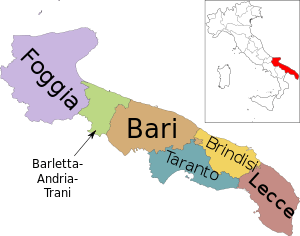Faraglioni
In Italian, faraglioni (pronounced [faraʎˈʎoːni]; Neapolitan: faragliune [faraʝˈʝuːnə]; singular faraglione in both languages) are stacks, a coastal and oceanic rock formation eroded by waves.
Faraglioni, seen from southern coast of Capri.

Faraglioni in Zagare Bay, Gargano National Park, Apulia.
The word may be derived from the Greek pháros or Latin pharus ("lighthouse") and is cognate with the Spanish farallón.[1]
They are found at the coasts of several regions of Italy:
Gargano faraglioni
In the Apulia region, faraglioni are found at the Gargano Peninsula, on the coast of the Adriatic Sea. Two are in Zagare Bay near Mattinata, protected within Gargano National Park.
Capri faraglioni
In the Campania region, there are three famous faraglioni in the Bay of Naples, off the island of Capri. Part of the Campanian Archipelago, they are named:
- Stella, connected to the island, 109 metres (358 ft).
- Mezzo, 82 metres (269 ft).
- Scopolo (or Fuori), 106 metres (348 ft). The blue lizard lucertola azzurra (Podarcis siculus coeruleus) is endemic to this faraglione.
See also
- Stack (geology)
- Coastal and oceanic landforms
| Wikimedia Commons has media related to Faraglioni. |
Gallery
- A faraglione in the Gargano National Park, Apulia
 Viewed from west, Capri.
Viewed from west, Capri. Viewed from east, Capri.
Viewed from east, Capri. Viewed from a boat, Capri.
Viewed from a boat, Capri.
References
- "Capri - Faraglioni". Capri Online. Retrieved 2010-10-08.
- "faraglióne (ant. o region. fariglióne)". Treccani.
This article is issued from Wikipedia. The text is licensed under Creative Commons - Attribution - Sharealike. Additional terms may apply for the media files.
